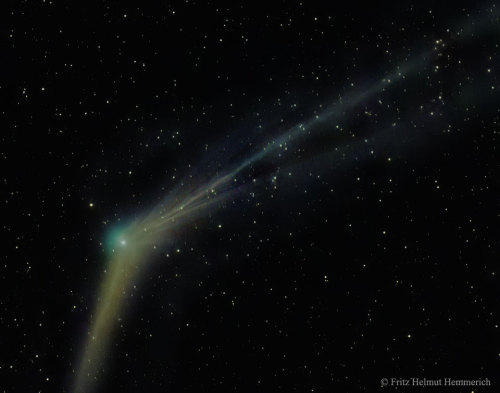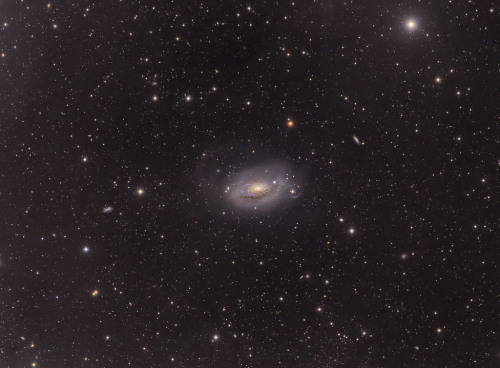Expedition 48 Crew Preparing To Return Home Via NASA Http://ift.tt/2bV7T75

Expedition 48 Crew Preparing to Return Home via NASA http://ift.tt/2bV7T75
More Posts from Littlecadet-biguniverse and Others

These three bright nebulae are often featured in telescopic tours of the constellation Sagittariusand the crowded starfields of the central Milky Way.
In fact, 18th century cosmic touristCharles Messier cataloged two of them; M8, the large nebula left of center, and colorful M20 near the bottom of the frame. The third, NGC 6559, is right of M8, separated from the larger nebula by dark dust lanes. All three are stellar nurseries about five thousand light-years or so distant. The expansive M8, over a hundred light-years across, is also known as the Lagoon Nebula. M20’s popular moniker is the Trifid.
In the composite image, narrowband data records ionized hydrogen, oxygen, and sulfur atoms radiating at visible wavelengths. The mapping of colors and range of brightness used to compose this cosmic still life were inspired by Van Gogh’s famous Sunflowers.
Just right of the Trifid one of Messier’s open star clusters,M21, is also included on the telescopic canvas.
Object Names: M8, M20, M2, NGC 6559
Image Type: Astronomical
Credit: NASA, AndrewCampbell
Time And Space

What is the difference between a supernova and a hypernova?
That’s a really good question, and the simple answer is that a hypernova produces way more energy than a standard supernova. Supernovae are known as being bright explosions from massive stars, and their remnant is usually a neutron star.

Hypernovae, however, more commonly produce black holes due to being from stars more massive than those that cause supernovae. Often time, they appear brighter too, which is why an alternate name for hypernovae is “superluminous supernovae”. Hypernovae are sometimes also the cause of gamma-ray bursts, a dangerous release of energy so high that it will fry anything in its path.

Thanks for asking! :)

Andromeda glowing in infrared.

Crescent Nebula

Galaxy Trio Arp 286:
NGC 5566 (bottom), NGC 5569 (left), & NGC 5560 (center)

Comet Catalina Emerges : Comet Catalina is ready for its close-up. The giant snowball from the outer Solar System, known formally as C/2013 US10 tails, making it an impressive object for binoculars and long-exposure cameras. The featured image was taken last week from the Canary Islands, off the northwest coast of Africa. Sky enthusiasts around the world will surely be tracking the comet over the next few months to see how it evolves. via NASA
js


“Rho Ophiuchi Cloud Complex Area Of The Milky Way” by Martin Campbell on Flickr.

M63 // Sunflower Galaxy
-
 alchemistbrain liked this · 5 years ago
alchemistbrain liked this · 5 years ago -
 fanartofthelostcities liked this · 5 years ago
fanartofthelostcities liked this · 5 years ago -
 mandoblando liked this · 5 years ago
mandoblando liked this · 5 years ago -
 imaginesofthefandoms liked this · 5 years ago
imaginesofthefandoms liked this · 5 years ago -
 eastern-wind liked this · 5 years ago
eastern-wind liked this · 5 years ago -
 stuffiebunny liked this · 5 years ago
stuffiebunny liked this · 5 years ago -
 jeebssred liked this · 5 years ago
jeebssred liked this · 5 years ago -
 di5app34r liked this · 5 years ago
di5app34r liked this · 5 years ago -
 xxfr0stb1tt3n-cl0v3rsxx liked this · 5 years ago
xxfr0stb1tt3n-cl0v3rsxx liked this · 5 years ago -
 tyyiyi liked this · 6 years ago
tyyiyi liked this · 6 years ago -
 16fahri liked this · 6 years ago
16fahri liked this · 6 years ago -
 daemondamian liked this · 6 years ago
daemondamian liked this · 6 years ago -
 bluebird-girl03 liked this · 6 years ago
bluebird-girl03 liked this · 6 years ago -
 sugarkaji reblogged this · 6 years ago
sugarkaji reblogged this · 6 years ago -
 lavender-blazeeeee liked this · 7 years ago
lavender-blazeeeee liked this · 7 years ago -
 joyyx9 liked this · 7 years ago
joyyx9 liked this · 7 years ago -
 starlovely liked this · 7 years ago
starlovely liked this · 7 years ago -
 nigelart reblogged this · 8 years ago
nigelart reblogged this · 8 years ago -
 bigethanlevi liked this · 8 years ago
bigethanlevi liked this · 8 years ago -
 princesitaayanai-blog liked this · 8 years ago
princesitaayanai-blog liked this · 8 years ago -
 a-perennial-quest liked this · 8 years ago
a-perennial-quest liked this · 8 years ago -
 th0ca liked this · 8 years ago
th0ca liked this · 8 years ago -
 xnebulessence reblogged this · 8 years ago
xnebulessence reblogged this · 8 years ago -
 stathoulakon reblogged this · 8 years ago
stathoulakon reblogged this · 8 years ago -
 movrings liked this · 8 years ago
movrings liked this · 8 years ago -
 yaorozu reblogged this · 8 years ago
yaorozu reblogged this · 8 years ago -
 azraelnemesis liked this · 8 years ago
azraelnemesis liked this · 8 years ago -
 fathomthepower-blog reblogged this · 8 years ago
fathomthepower-blog reblogged this · 8 years ago -
 anneelizabeth97 liked this · 8 years ago
anneelizabeth97 liked this · 8 years ago -
 itstotallykyletime reblogged this · 8 years ago
itstotallykyletime reblogged this · 8 years ago -
 itstotallykyletime liked this · 8 years ago
itstotallykyletime liked this · 8 years ago -
 joposimo reblogged this · 8 years ago
joposimo reblogged this · 8 years ago -
 joposimo liked this · 8 years ago
joposimo liked this · 8 years ago
GREETINGS FROM EARTH! Welcome to my space blog! Let's explore the stars together!!!
144 posts